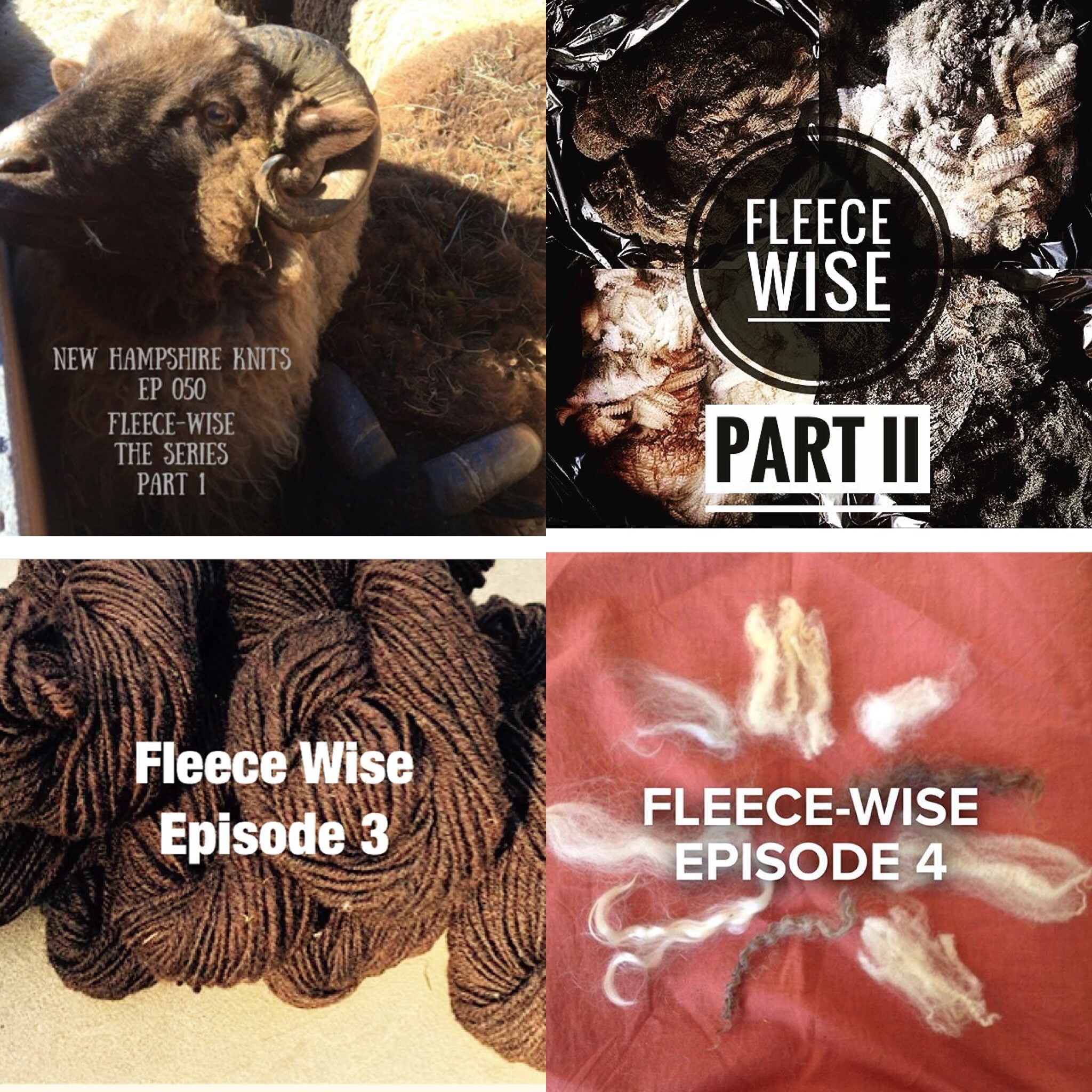Sarah Hunt, host of the Fiber Trek podcast, sent us this wonderful post for Wovember. While it WAY exceeded our word count for the ‘woolness and me’ posts, we thought it would make a very special “woolness and us” story. This Wovember we have seen how wool contributes to wide ideas and examples of wellness. Wool also makes connections – not only connecting us to the sheep and the land, but it connects us to others in our love of wool and craft too. Sarah introduces us to her wool pack today and these four women discuss their connections to fleece, to craft and to one another.
Twenty years ago, aboard a ferry bound for Stromness, I had little affinity for knitting and wool. My childhood had been spent at the side of my Southern grandmother—sewing, cross stitching, exploring the wonders of pastry, and longing to be Laura Ingalls Wilder just so I could experience the smoky comfort of a log fire.
But there I was, twenty, no pastry to be seen or fireplace for that matter, on an Orkney-bound ferry in the North Sea in January, in the worst possible gale conditions. Winds were so bad, we could not dock for fear of the surf lifting the boat into the town beyond the pier. I spent eight additional hours riding out that storm on the sea. Plenty of time to meet a shepherd, share with him his first bagel, and begin an epic love affair. In hindsight, the affair began with a man but it ended with the sheep. Suffice it to say these are my roots in sheep and wool. My love for the island and farm in Orkney was so deep, I needed to find a way to connect with that place every day even though I couldn’t stay forever. Below is a passage from Soulful Stash, my original blog post.
“I came to the craft of knitting . . . cold off the lambing hill, though the mist and damp, tired and slightly bereft. I came to the craft of knitting . . . carrying chilled lambs, smeared with manure, and high with the miracle of healthy, spry triplets. When I knit or spin this is where I go. I go back to the heather hill, to long nights, well-deserved naps and hot steaming mugs of tea.”
Since that time, I have “spun” many adventures, mostly by myself. I did not have spinning or knitting friends, nor friends who cared so strongly for wool. Seven years ago, I moved from a small village in southern Maine to unorganized territory where the Appalachian trail terminates. This is a mostly mountainous, forested landscape with many lakes and rivers, but much to my chagrin, no internet. I worked hard for three years to find a reliable source of wi-fi and once I secured that connection and howled my woolly howl—Ai! did the wool pack come running!
Enter three dear friends who all get me, who all get it. The raw fleece, the heather hill, the steaming mugs of tea. They acknowledge that visceral experience one can have with place and time and tradition when wool is involved. And I’m not talking superwash here. I’m talkin’ greasy, mucky, oh-so-sweet locks of grass and sunlight. The internet has afforded me a lot in the way of community and resources and I am ever thankful for that neighbor across the pond who has allowed me to beam off his receiver.
Like my beginning, on the blowy North Sea, I’d like to see where the wind takes me this time.
So, who are these pack members? They are the Fleece-wise team of podcasting friends: Emily of Fibre Town, Claire of New Hampshire Knits, and Sara of Yarns at Yin Hoo.
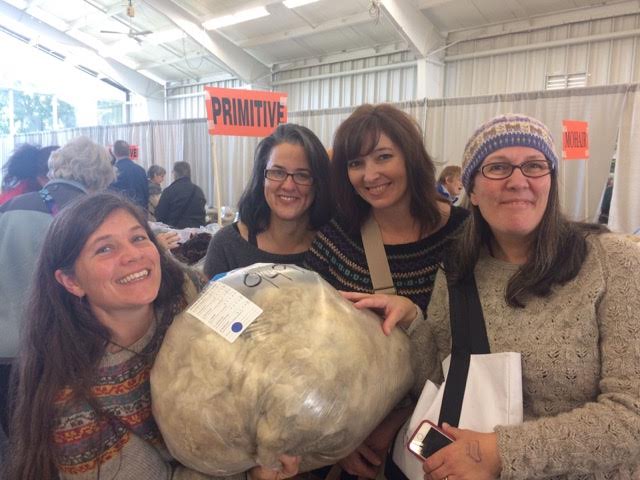
******
Emily
It’s the Maryland Sheep and Wool Festival, 2009. I’ve arrived for my first wool festival with bells on and a healthy budget for yarn buying. As I arrive, I see folks carrying trash bags. They are lugging trash bags full of wool, raw wool, out to their cars. What is the deal with that? As a newish knitter, I’m excited by colorful, soft, superwash wools and give little thought to the raw materials that form the basis of those yarns. Dirty, stinky raw fleece is a foreign concept to me.
But that sight planted a seed that grew over the following years. It led to new connections to place and people, through wool craft.
Wool people crave connection to others who understand the obsession. For me, that obsession led to making a weekly podcast, Fibre Town, in order to make connections within the wool community. Wool people seek out fellowship with other capital-K knitters. We inspire each other with project and color ideas. We teach each other things—techniques and new ways of approaching our craft as a connection to place and experiences. That last part was completely unexpected to me, but I should have seen it coming.
It seems inevitable that our group, four fiber arts podcasters, should find each other. We organized ‘soulful stash’ swaps with our viewers and listeners. We hosted virtual knit nights via Google chat. We arranged to meet up at the Maryland Sheep and Wool Festival, and Rhinebeck. The proper name of Rhinebeck is the New York Sheep and Wool Festival, which is held in Rhinebeck, New York, but it has somehow become the Cher of the fiber world, known by a single word. What we found in each other, and continue to develop, is a desire to connect ourselves to place and each other through sheep and the wool they grow.
Since that first Maryland festival, the seed grew. I’ve delved into hand processing and spinning sheep breeds that go beyond the Merino monoculture that defines not just the fashion wool industry, but the handknitting world as well. I’ve worked with Icelandic, Finn, Jacob, Manx Loaghtan, Cotswold, Coopworth, Corriedale, Rambouillet, Cormo, Leicester Longwool, Gotland, Wensleydale, Shetland, North Ronaldsay, California Variegated Mutant, Hog Island, Border Leicester and more. I’ve met amazing shepherds working to preserve rare breeds. I’ve been influenced by Sarah’s love of long wools, Claire’s Scottish heritage and the amazing variety of British sheep breeds, and Sara’s thoughtful study of all things woolly. The result of these connections is a dresser full of shawls and sweaters, and the friendship of three wool women who inspire me.
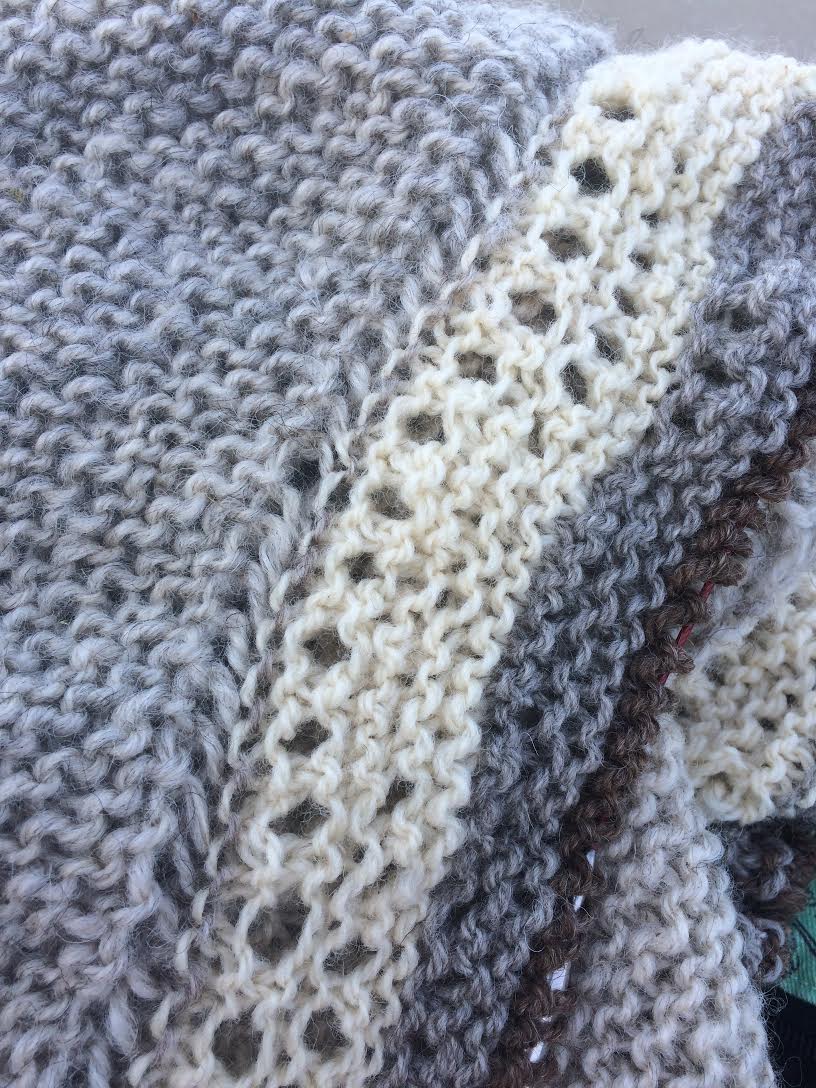
Claire
In 2010, I was crocheting a blanket for my soon-to-be son with a wool/acrylic blend of yarn and didn’t think anything about that choice, so long as it felt soft. At about the same time I began reading knitting blogs and found myself being drawn to knitting, which I’d learned as a child from my mother in Scotland, but in which I’d long since lost interest.
My son’s adoption was hard and protracted. Knitting became more and more an outlet for anxiety and helped me fill the waiting time in a productive way. In 2012, I finally boarded a plane to Ethiopia. In my carry-on luggage was a small sweater in the making.
And now, with a very active son (and a beautiful daughter), I am still knitting. My knitting serves as an outlet for my need to create and is always welcome relief after a busy day. Knitting grounds me and as such, knitting and yarn have taken on greater importance in my life. I want to knit with woolly wool and make beautiful things that act as bookmarks, reminders of what was happening in my life at the time something was being knitted, or when it was completed. The object itself may be less important than the making of it or the materials I have chosen.
As knitting and yarn became more important to me, I started a podcast, to see if I might be heard. It was like shouting in the wind, hoping to hear an answer. And so many voices answered. So many knitters and spinners have come into my life, each with their own reasons for being as passionate about their materials and processes as I am. Sarah’s was one such voice. We organised a “soulful stash” swap where I began to learn about the treasures of local wool as well as “placed-based” wool and yarn. She gave me a spinning wheel that she no longer had room for and encouraged me to learn to use it. Through her, I met Emily and Sara (both of whom I already watched and listened to) and friendships deepened over the internet.
Friendships continue to grow as well as my yarn and knitting knowledge. Also growing is my shop specialising in UK yarns, The Woolly Thistle.
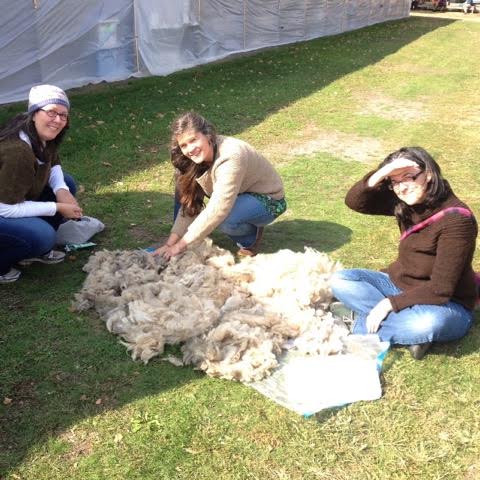
Sara
The bus unloads and I rush toward the gate of the Howard County Fairgrounds to enter the 2014 Maryland Sheep and Wool Festival. I’ve agreed to meet Sarah at the Fingerlakes Woolen Mill booth, where we will purchase roving made from fiber of Hog Island sheep.
Prior to my arrival, I have read all about this feral breed and its characteristics—in my newly-acquired Fleece and Fiber Sourcebook. The terms feral, primitive, and conservation are new to me, but I’m learning quickly. Sarah’s excitement made me think there would be a crowd queuing for this rare and hard-to-find fiber, but we have the booth to ourselves as we make our selections.
Our next stop is the Fleece Barn. There is a steep learning curve ahead, I can tell, and I’m already dizzy from the energy of shoppers and the sheepy smells that surround me. I listen to Sarah’s steady stream of information as I stick my hand into bag after bag after bag. Then, we spot Emily, already in the checkout line, several fleeces at her feet. “Fibre Town,” we shout across the barn, and Emily looks up, smiling.
A fascination with the stories of sheep breeds and the specific and special characteristics of their fiber has caught me in its grasp. I couldn’t have known, on that humid May morning, how much I would grow as a result of this interest.
Two years later, I am headed down the hill of Dutchess County’s pristine fairgrounds toward the fleece sale, but first I have a few stops to make. My interest in woolly things and the value of process over product has prompted me to enroll in a year-long Sheep to Shawl course at Fiber Craft Studio. We began in January with raw fleece and have learned the processes for washing, carding, spinning, dyeing, and finally designing and knitting a finished garment. I step into the Fiber Craft Studio booth, where my teachers, Chris and Sono, are busy helping shoppers make their selections of botanically-dyed yarn in soft and muted colors. Next stop, The Ross Farm, to purchase six ounces of roving—in creamy white and oatmeal colors, as well as an unusual chocolate brown—from their Hog Island sheep. This booth, which offers farm yarns and roving (no vibrant colors here) is already crammed with shoppers at an early hour.
The fleece sale, which once intimidated me beyond belief, now prompts excitement and anticipation. I’m feeling fleece-wise as I join Sarah, Emily and Claire. For the past few months, we have worked together to educate our podcast listeners and viewers. Now we are here, at Rhinebeck, to make a fleece purchase and continue the journey that has brought us closer to each other, and closer to the sheep.
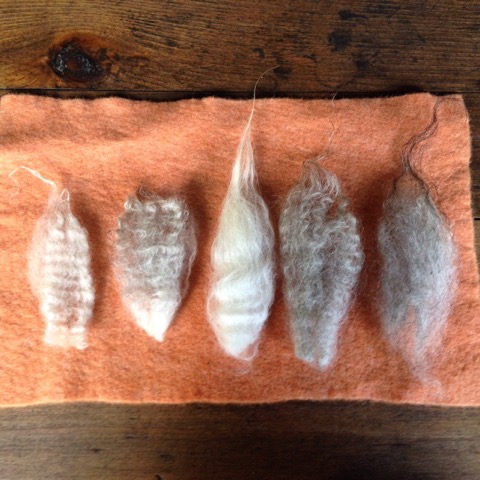
*****
Sarah
We came together to initiate Fleece-wise for a number of reasons. One was to tell our stories. Another was to reflect on a series of questions regarding place. We wanted to engage our audience with these questions and create a forum for the collective wisdom of the fiber community. Our mission is to perpetuate the tradition of spinning as well as highlight the importance wool. We want beginners, experts, and non-spinners to participate and feel that they can access this community too.
Our group of friends, cheekily known as the Wool Wenches, devised a scheme to share knowledge and grow connections within our community. Our premise was this:
If you have felt, as we did, that the fleece tent at a fiber festival is overwhelming and intimidating, if you’ve been considering a fleece purchase, if you have unprocessed fleece languishing in storage, if you’re experienced in fleece processing, you are invited to participate in the discussion threads, ask questions and share ideas. Podcast hosts will be facilitating discussion threads and awarding prizes for engaging in discussion.
Claire began the Fleece-Wise podcast series by interviewing two local shepherds about the work that goes into growing fleeces for sale to handspinners. Sarah followed up with a demonstration of preparing a shorn fleece for sale, as well as a discussion of her personal wool politics. Emily shared a tour of the fleece sale at Shenandoah Fiber Festival, as well as tips for buying a fleece. Sara concluded the series with a discussion of washing and preparing fleece for spinning.
At Rhinebeck we pooled our knowledge and money to purchase a fleece together. We decided on a primitive breed. Our fleece comes from Montana and Carol Airey of Wild Air Shetlands in Bolton, Massachusetts. In the next stage, we will share what we do with the beautiful fiber of Eloise, the Shetland sheep. Fleece-wise is four women, pulling in the same direction, where great things can happen.
Thank you so much to Sarah, Emily, Clare and Sara for writing about their wool pack and how wool has creates amazing connections!
You can listen to the Fleece Wise series at each of the four podcasts.
Episode four – Yarns at Yinhoo
